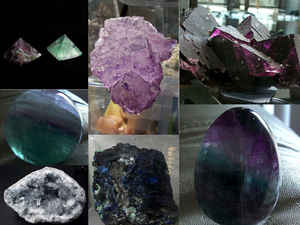
Massachusetts Symbols
Massachusetts State Mineral or Mineral Emblem
Babingtonite
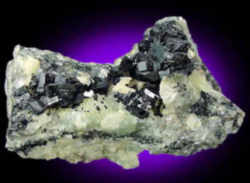
{Ca2(Fe,Mn)FeSi5O14(OH)}
Adopted in April of 1971.
The finest quality Babingtonite in America has come from the state of Massachusetts. Although the Commonwealth is not overly blessed with mineral resources, it is one of the few locations in the world where this usually jet black material with a brilliant submetallic luster is found. The Legislature adopted Babingtonite in April of 1971 as Massachusetts' official state mineral
Massachusetts State Mineral or Mineral Emblem : Babingtonite
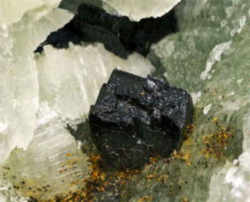
Babingtonite, the State Mineral of Massachusetts, is a mineral occurring in triclinic crystals approaching pyroxene in angle, and of a greenish black color. It is a silicate of iron, manganese, and lime and is named after Irish physicist and mineralogist W. Babington. It belongs to a class of minerals called silicates, and appears as small, wedge-shaped black crystals. It is hard (5.5-6 on the Mohs scale), heavy, and exhibits good prismatic cleavage and uneven fracture. Crystals of Babingtonite growing with Prehnite or Calcite can be found lining basalt, gneiss, or granite cavities. Babingtonite is considered a mineral of interest to collectors and mineralogists.
Babingtonite has been found at a number of locations in Massachusetts. The best known location is a basalt quarry in Westfield. The old Cheapside Quarry in Deerfield has produced many beautiful specimens. Small, but lustrous specimens are still being recovered at Shaft 10 (part of the Quabbin Reservoir Aqueduct), in West Warren.
PHYSICAL CHARACTERISTICS OF Babingtonite
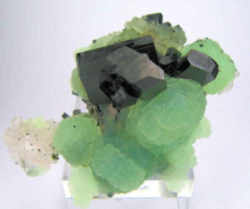
Babingtonite is a calcium iron manganese inosilicate mineral with the formula Ca2(Fe,Mn)FeSi5O14(OH). It is unusual in that iron(III) completely replaces the aluminium so typical of silicate minerals. It is a very dark green to black translucent (in thin crystals or splinters) mineral crystallizing in the triclinic system with typically radial short prismatic clusters and druzy coatings. It occurs with zeolite minerals in cavities in volcanic rocks. Babingtonite contains both iron(II) and iron(III) and shows weak magnetism. It has a Mohs hardness of 5.5 to 6 and a specific gravity of 3.3.
It was first described in 1824 from samples from Arendal, Aust-Agder, Norway (which is its type locality) and was named after the Irish physician and mineralogist William Babington (1757-1833).
- Color is almost always black to dark green.
- Luster is vitreous.
- Transparency: Crystals are generally opaque but thin crystals or splinters can be translucent.
- Crystal System is triclinic; bar 1
- Crystal Habits include short stocky prismatic crystals or tabular to platy forms.
- Cleavage is good in one direction and perfect in another, these are pinacoidal but are at near right angles to each other forming rectangular prisms.
Babingtonite Folklore
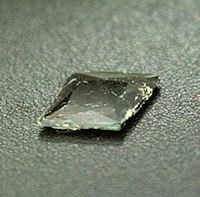 Healing:
Babingtonite is used to treat issues related to the thyroid. It is used to ameliorate distressed conditions related to the throat and heart and to
enhance one's sense of taste.
Healing:
Babingtonite is used to treat issues related to the thyroid. It is used to ameliorate distressed conditions related to the throat and heart and to
enhance one's sense of taste.
Workings: Babingtonite is used during "re-birthing" sessions to enhance ones understanding of the blockages that are removed and the reason why they existed. It is also used to overcome shyness and rectify a negative outlook on life.
Babingtonite is associated with the astrological sign of Gemini and vibrates to the Master number 55.
Chakra Applications: Babingtonite is used to energize the Heart chakra.
Massachusetts Law
The law designating Babingtonite as the official Massachusetts state mineral or mineral emblem is found in the General Laws of Massachusetts, Part 1, Title 1, Chapter 2, Section 18
PART I ADMINISTRATION OF THE GOVERNMENT
TITLE I JURISDICTION AND EMBLEMS OF THE COMMONWEALTH, THE GENERAL COURT, STATUTES AND PUBLIC DOCUMENTS
CHAPTER 2 ARMS, GREAT SEAL AND OTHER EMBLEMS OF THE COMMONWEALTH
Section 18 Mineral or mineral emblem of commonwealth
Section 18. Babingtonite shall be the mineral or mineral emblem of the commonwealth.
Minerals, & Gems

Gemstone, Minerals, Rocks





